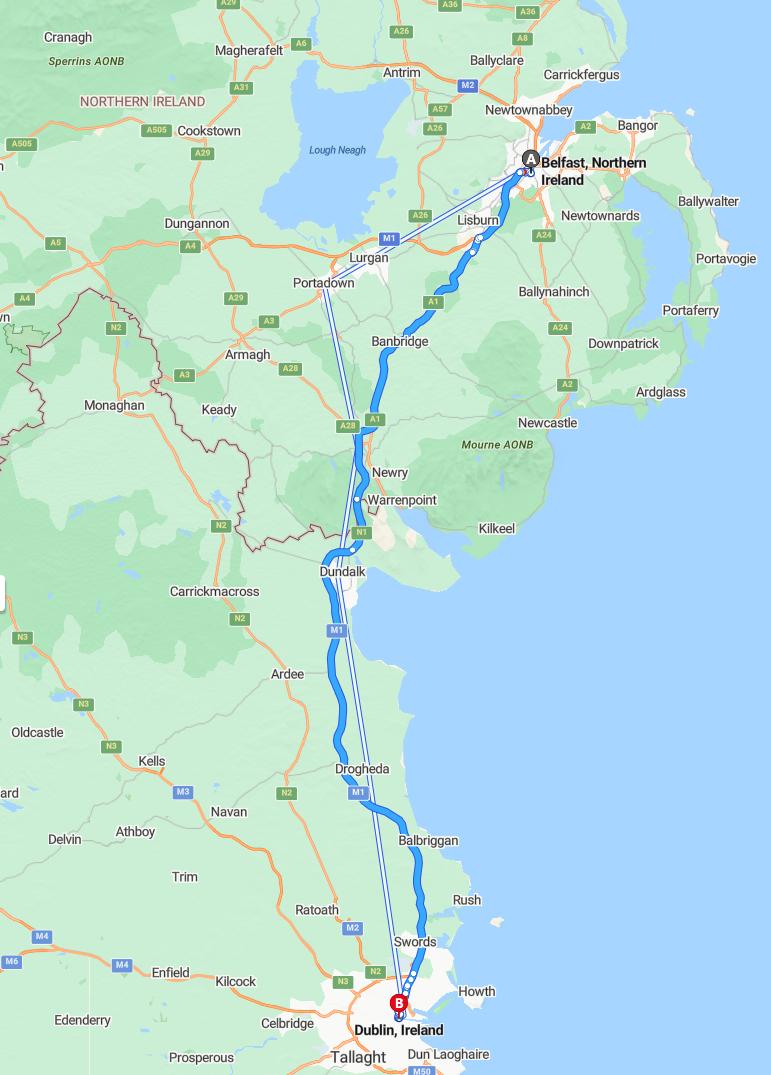Distance and estimated driving time
Driving from Belfast to Dublin typically takes a minimum of approximately 2 hours, covering around 103 miles. The primary route involves traveling via the M1 and A1 motorways, ensuring a relatively straightforward journey. These roads are well-maintained, facilitating smooth traffic flow between the two cities. Travelers should consider potential delays during peak hours or adverse weather conditions for more accurate planning.
Driving route
The scenic drive from Belfast to Dublin takes travelers through a series of vibrant towns and cities, beginning in Belfast, Northern Ireland, and passing through Lisburn, known for its historical sites. As you continue south, Portadown offers a glimpse into Ireland's rich industrial heritage, while Newry provides stunning views of the surrounding countryside. Approaching the border, Dundalk welcomes visitors with its lively atmosphere and cultural attractions, leading to Swords, a suburban town with charming shops and parks. Finally, the journey concludes in Dublin, Ireland's bustling capital, where history, culture, and modern amenities converge to offer an unforgettable experience.

Road conditions and travel advisories
Travelers driving from Belfast to Dublin can generally expect well-maintained roads and smooth driving conditions along this route. However, it is advisable to stay updated on any current travel advisories, especially during adverse weather or peak traffic times, which may cause slight delays. Some sections, particularly around urban areas like Dundalk and Swords, can experience congestion during rush hours, so plan accordingly. Checking real-time traffic reports before departure will help ensure a safe and efficient journey between Northern Ireland and Ireland.
Toll and fee information
Traveling from Belfast to Dublin involves several tolls and fees along the route. In Northern Ireland, there are no tolls on the M1 motorway leading south, making the journey relatively toll-free until you cross into the Republic of Ireland. Once in the Republic, toll charges apply at the M1 motorway near Dublin, where you will encounter toll plazas that require electronic or cash payments. It's advisable to prepare for these fees by having the appropriate payment options ready, ensuring a smooth and hassle-free journey across the border.
Recommended rest stops and break points
When driving from Belfast to Dublin, it is advisable to take regular rest stops to ensure safety and comfort. A convenient point for a break is Lisburn, where you can refresh at local cafes or service areas. Continuing south, Portadown offers opportunities for a quick rest at roadside facilities, while Newry provides options to stretch your legs and grab a snack. As you approach the outskirts of Dublin, stopping in Dundalk or Swords allows for a brief break before reaching your final destination, helping to reduce fatigue and enhance the overall journey experience.
Traffic updates and peak hours
When driving from Belfast to Dublin, travelers should be mindful of traffic conditions and peak hours along the route, which includes stops at Lisburn, Portadown, Newry, Dundalk, and Swords. Typically, morning rush hours between 7:00 AM and 9:00 AM and evening peak times from 4:30 PM to 7:00 PM can cause significant delays, especially near major urban centers like Belfast, Dublin, and Swords. It is advisable to check real-time traffic updates before departure to avoid congestion, particularly on routes approaching Dublin due to commuter traffic. Planning your journey outside peak hours or allowing extra travel time can help ensure a smoother and more efficient trip.
Parking facilities at destination and along route
Parking options in Dublin include numerous city-center parking garages, metered street parking, and park-and-ride facilities for convenient access to attractions. Along the route from Belfast to Dublin, travelers will find various parking areas in towns like Lisburn, Portadown, and Dundalk, often with free or paid options depending on the location. Many of these towns offer public parking lots near main roads and town centers, making it easy to stop and explore. In Dublin itself, parking can be limited and expensive, so using designated parking stations or public transit is recommended for visitors aiming to avoid high costs and traffic congestion.
Safety tips for cross-border driving
When driving from Belfast to Dublin, it is essential to prioritize safety by ensuring your vehicle is in good condition and equipped for the journey. Be aware of different traffic laws and speed limits in Northern Ireland and the Republic of Ireland, and always follow posted signs to avoid confusion. Carry your driver's license, vehicle registration, and proof of insurance, as these are required for cross-border travel. Additionally, stay alert for changing road conditions and plan your route in advance to ensure a smooth and safe trip across the border.
Local speed limits and driving laws
When driving from Belfast to Dublin, it's essential to be aware of local speed limits and traffic regulations. In Northern Ireland, the standard speed limit is 60 mph (96 km/h) on rural roads and 70 mph (112 km/h) on motorways and dual carriageways, with strict enforcement. Once you cross into the Republic of Ireland, the speed limit drops to 50 km/h (31 mph) in urban areas and 100 km/h (62 mph) on rural roads and motorways. Additionally, both jurisdictions require drivers to drive on the left side, wear seat belts at all times, and avoid using handheld mobile phones while driving to ensure safety and compliance with the law.
Emergency contacts and roadside assistance
While traveling from Belfast to Dublin, it's essential to have access to emergency contacts and roadside assistance services along the route. Ensure you have local emergency numbers saved, such as 999 in Ireland, and know the contact details for your breakdown coverage provider. Many major motorways and service stations in Northern Ireland and the Republic of Ireland offer roadside assistance, so familiarize yourself with their locations. Carrying a fully charged mobile phone and necessary emergency supplies can help you stay prepared in case of unforeseen incidents during your journey.
